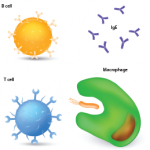The traditional fluorescence-based approach, he said, “doesn’t leave a lot of room to look at the things I think a lot of researchers are generally interested in, which is cell behavior. Is the cell dividing? Is it dying? Is it signaling? Is my drug doing something to it? Do the cells die more, or signal more or less?”
In one of the first mass cytometry applications, researchers captured a snapshot of all the hematopoietic immune cells in healthy human bone marrow—at the same time, in one experiment.
They created an algorithm called “SPADE,” with cluster size representing the number of cells in the cluster, and with colors representing the marker researchers wanted to display. They used only about half of their available markers on phenotypic traits, which left plenty of markers to track behavioral characteristics.1
“You can then use this model to compare these different conditions and see how they perturb behavior of the cells, and in what cells it’s going on,” Dr. Bendall said.
We’ve got the ability to measure millions of cells per day, & now we’re pushing up to 50 parameters for every cell in our experiment. —Dr. Bendall
He underscored the element of discovery possible with the approach.
“Even though we were doing a completely targeted assay—we knew what we were measuring ahead of time—we were still generating de novo information,” he said. “I didn’t need to know exactly where the activity was going to be, because I was capturing and organizing all the cells at the same time.”
More recently, researchers have used the approach to track the behavior of chimeric antigen receptor T cells, in which immune cells are engineered and re-infused and then expand in the body in an attempt to better attack cancers such as lymphoma. They’ve developed a tool to model this process and assign each cell a division ID, and can use the dilution of dyes to follow the cells’ division because as the cells divide, the dyes dilute. And, they can track the cells’ characteristics along the way.
“We’ve got the ability to measure millions of cells per day, and now we’re pushing up to 50 parameters for every cell in our experiment,” Dr. Bendall said.
For instance, by tracking CD-69, a commonly observed cell-activation marker, researchers could tell the cells chose one phenotype over another very early in the process.
“Almost all [cell] decisions are being made in terms where the cells are going, and what they’re becoming, prior to the first division,” Dr. Bendall said. Researchers have also found the cells seem able to be manipulated without much loss in terms of expansion.

